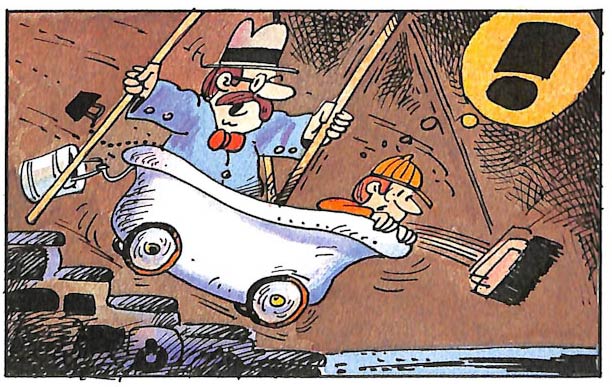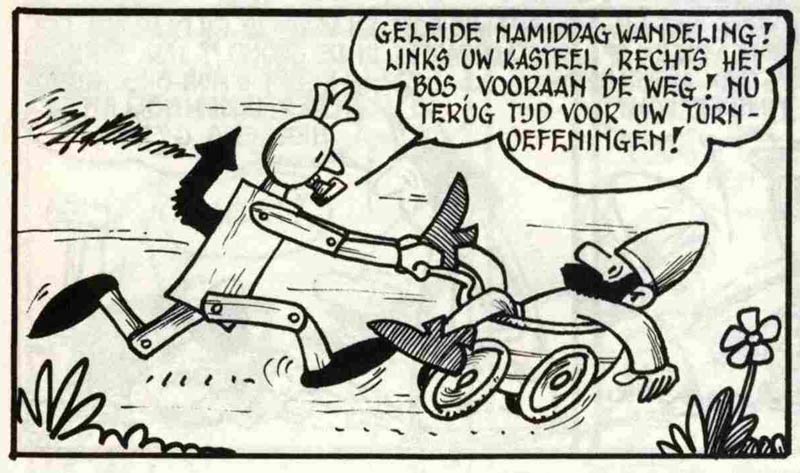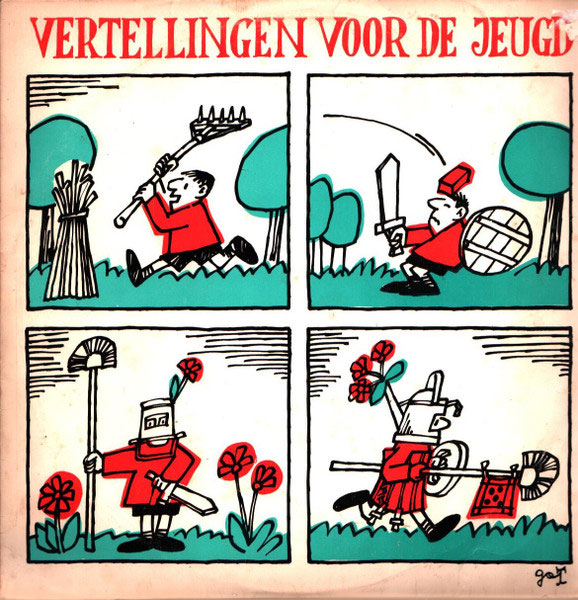'Jonas en de Wonderwinkel'.
Gommaar Timmermans, better known as GoT, was a Flemish comic artist and book illustrator. He started out drawing children's comics for De Patskrant, among them 'Fideel de Fluwelen Ridder' (1962-1976) and 'Jonas en de Wonderwinkel' (1974). The latter comic was adapted into a 1979 animated TV series. Starting in the early 1970s, GoT gradually aimed for an adult, intellectual readership. His best known comics from this era were 'De Nieuwe Ark' (1972), 'Iamboree' (1972-1982) and 'Weber' (1972-1982), that ran in opinion magazines like De Nieuwe and Knack. All were notable for their nonsensical comedy, cultivated language, philosophical themes and lack of easy punchlines. At the time, they stood out in the Flemish comic industry as uncompromisingly adult, personal and thought-provoking.
Early life
Gummarus Hieronymus Rachel Felix Maria Timmermans was born in 1930 in the city of Lier as the son of famous Flemish novelist Felix Timmermans (1886-1947). Best remembered for his classic novel 'Pallieter' (1916), Felix Timmermans occasionally drew little vignettes to illustrate his novels. While these were far from professional drawings, they sparked his children's interest in drawing. Gommaar's older sister Tonet Timmermans (1926-2020) later became well-known as a painter, illustrator and occasional comic artist. His other sisters also turned to creative professions: Lia (1920-2002) became children's book writer and Clara (1922-2016) a writer, singer and poet. As a child, Gommaar Timmermans read various comics, but his main graphic influences turned out to be Walt Kelly's 'Pogo', Johnny Hart's 'B.C.' and George Herriman's 'Krazy Kat'. Timmermans graduated in interior design from the Higher Institute of Architecture and Urban Planning (Hoger Instituut voor Bouwkunde and Stedenbouw) in Antwerp, but never worked in this field. At the Antwerp Academy, he additionally studied advertising and ceramics.
Early career
While still a student, Timmermans got his start in the comic industry. Through his father's artistic circle of friends and colleagues, Timmermans got in touch with the editor-in-chief of the comic magazines Ons Volkske and Kuifje, Karel van Milleghem. Between 1950 and 1955, the youngster was able to contribute to these magazines as a writer. He penned a couple of humorous text stories, the majority illustrated by Bob de Moor and his sister Tonet. Others featured artwork by Rik or Jacques Laudy. Timmermans' writing job was born out of financial need, as the 18-year old boy had just bought an old army jeep. Between 1955 and 1957, Timmermans worked as an advertising designer for the petrol company Esso. He got married in 1957 and moved to Ostend, at the Belgian coast. He got a job with the publishing company Desclée De Brouwer in Bruges, but the company was threatened by bankruptcy and the young artist decided to try his luck elsewhere. In 1961, Timmermans moved back to his birth town of Lier.
Gommaar Timmermans was introduced to the readers with the publication of his first text story in Kuifje #42, 1950.
Early cartoons and comics
In 1958, Gommaar Timmermans made his debut as a cartoonist in the magazine Flash. It was here that he first used his pseudonym: GoT, a combination of the first two letters of his first name and the first letter of his surname. When asked why he used a capital 'T', Timmermans replied: "All last names are written with a capital letter, aren't they?". Between 1961 and 1964, GoT made his first, untitled, gag comic in De Bond. For the Sunday newspaper De Zondagmorgen, he successively made the 'Sylvester Beukenoot' strip (21 March to 3 October 1963), as well as the 'Batman' parody 'Gabriël Gagman' (1966). For the readers of the women's magazine Rosita (nowadays Libelle), GoT created the serialized short stories 'Het Zondagskasteel' (1969), 'De Kip, De Keizer en de Tsaar' (1970) and 'De Grote Ballonreeks' (1971). In 1973, 'De Kip, De Keizer en de Tsaar' was published as a children's book; in Belgium by Angelet and in the Netherlands by Schuyt & Co. The story stars a chicken, recruited in Napoleon's army during the 1812 invasion of Russia.
Fideel de Fluwelen Ridder
GoT was also an original contributor to De Patskrant, a new children's supplement of newspaper De Standaard. Editor and Journalist Gaston Durnez asked Timmermans to create a comic strip for the publication, launched on 5 September 1962. GoT's gag comic 'Fideel de Fluwelen Ridder' (1962-1973) took off in the first issue and featured the rivalry between a medieval knight with flowers coming out from under his helmet and the blackbearded castle lord Bambozijn. The cartoonist later recalled that at the time, he still lacked some technical drawing skills. Not good at drawing feet, he always hid them in the grass. Since they had four feet, horses were even more problematic. But as the series progressed, his skills improved.
Originally purely a children's comic, GoT gradually shifted the tone of his comic into eccentric and nonsensical comedy, with archaic words and expressions. When young readers complained they didn't understand Fideel's gags any longer, the editors interfered. In March 1974, 'Fideel de Fluwelen Ridder' moved to De Standaard's regular pages instead. Remodeled as a four-panel gag comic, it continued until its final episode appeared in print on 2 December 1976.
'Fideel de Fluwelen Ridder'.
Other work in De Patskrant
Timmermans' other comics in De Patskrant were peculiar too. Between 14 April 1965 and 5 October 1971, De Patskrant ran GoT's 'De Nonsensikale Tweehoofdige Gevlekte Filodendron' (1965-1971), a gag comic starring a two-headed, spotted creature named the Filodendron. His two heads were a metaphor for the two-sided nature of mankind. On 7 December 1971, the readers were introduced to 'Arabella, de Geleerde Slak' (1971-1972), a wise snail, whose gags appeared until 25 June 1972. Timmermans also contributed shorter-lived comics, such as 'Pepijn' (1974), 'Felix en Pepino' (date unknown) and 'De Drie Musketiers' (date unknown). Many of GoT's playful and nonsensical comic strips proved too difficult for children, and most were canceled after a couple of years. His longest-running and most straightforward contribution to De Patskrant was the joke section 'Pietje Pennewip' (1965-1996), for which editor Cyriel Verleyen wrote the jokes and Timmermans provided illustrations. A 1975 book compilation was published by Lannoo: 'Lach Maar Liever Met Pietje Pennewip'. It also featured artwork by Dani Dacquin.
Jonas en de Wonderwinkel
Between 28 February and 3 September 1974, De Patskrant serialized GoT's final and most fondly remembered children's comic, 'Jonas en de Wonderwinkel' ("Jonas and the Miracle Shop"). Nevertheless, it was far from ordinary, following a surreal and imaginative storyline. Jonas is a young boy who has trouble memorizing Columbus' discovery of America for a school test. A special chestnut improves his memory, but he loses it while visiting a magical store. Together with his rabbit Gabriël and the store owner - nicknamed "De Kapitein" ("The Captain") - Jonas tries to find it back. After transforming a bathtub into a vehicle, they drive to the cellar and travel through a time portal, ending up in the year 1492, where they meet Columbus.
Five years later, 'Jonas en de Wonderwinkel' found a new audience when the comic was adapted into a 1979 children's TV series on the Flemish public channel BRT (nowadays the VRT). GoT himself did the storyboards, character designs and backgrounds, while the animation was produced by Pen Film, in collaboration with Raoul Servais. Future comic artist Marc Verhaegen was one of the animators for the series. Besides Ugo Prinsen as the narrator, the show had Stijn Peeters, Denise De Weerdt, Jef Burm, Maurits Goossens, Jackie Morel, François Bernard, Bob Van der Veken, Door Van Boeckel, Emmy Leemans, Alex Wilequet, David Davidse, Ward De Ravet, Jos Verbist, Karel Vingerhoets and Walter Cornelis as voice actors. To appeal to young viewers, the plot and tone of the TV adaptation were simplified. The 'Jonas en de Wonderwinkel' series brought new attention to GoT's original comic. In 1979, the story was published in book format for the first time by C. de Vries-Brouwers; it was reprinted in 1987 by Den Gulden Engel.
De Nieuwe Ark
In 1972, GoT began a collaboration with the Flemish opinion magazine De Nieuwe. The editors gave him complete creative freedom and the cartoonist took full advantage of this opportunity. Between 7 January and 8 September 1972, he created the comic series 'De Nieuwe Ark', about a group of animals that build a paper ship out of fear "something might happen". They travel the world to seek a place where they might be safe. GoT was inspired by the Hieronymus Bosch painting 'Het Narrenschip' ('Ship of Fools'). 'De Nieuwe Ark' has many double layers and philosophical undertones. The series was compiled in two different books. 'De Nieuwe Ark' (Blues, 1981) featured all 24 comic episodes, while 'De Stille Ark' (Lannoo, 1984) brought the story as an illustrated children's story. The latter also received an English translation under the title 'The Silent Ark' (Methuen Children's Books, Ltd., 1984).
Weber/Iamboree
While attending the wedding party of one of the children of Patskrant editor Cyriel Verleyen, GoT met Verleyen's brother Frans, the founder and chief editor of the opinion magazine Knack. Shortly afterwards, GoT was given his own spot in this magazine. In September 1972, the first episode of his four-panel gag comic 'Weber' (1972-1982) was published. The main characters are Weber, a ladybird in a paper hat, and the tortoise Arnold. The same month, on 13 September 1972, another long-running series by GoT was launched: 'Iamboree' (1972-1982). A full-page comic, 'Iamboree' is set in ancient Greece. The episodes feature ancient Egyptians, Greeks and Romans discussing existential questions, math, science and politics. Both comics were notable for their cultivated dialogues and lack of straightforward punchlines. In 2011, Strip Turnhout published a 'Iamboree' compilation book.
'Iamboree'. Translation: "This is a dodecahedron! A competition dodecahedron! Look! And mind your head!" - "It's high time that we learn how to speak abstract!!"
Other late 1970s/early 1980s magazine work
In the mid-1970s, GoT also worked for the monthly magazine Avenue, which published articles for both Dutch and Flemish readers in separate sections. His gag comic 'De Palavers van Savarin' (September 1973) appeared irregularly on the Flemish pages. The feature was set in the real-life café Savarin (that no longer exists) at the Belgiëlei in Antwerp. The purely verbal jokes centered around the conversations between bar owner and his clients. In 1977, GoT published the gag comics 'Alfred' (1977-1979) and 'Topaas' (1977) in E-3 Magazine, followed in 1978 and 1979 by cartoons for De Bond. Some of his cartoons were translated into German, appearing in the magazines Quick and the Neue Illustrierte. From February until March 1982, GoT's comic strip 'Frons' ran in Johan Anthierens' satirical magazine De Zwijger.
Book illustrations
Timmermans wrote and illustrated several children's novels, including two books in the series 'De Stotterende Koekoek' ("The Stuttering Cuckoo"): 'Alfred Vliegt Naar De Stad' (1972) and 'Alfred Keert Terug Naar Het Bos' (1972), both published by Angelet & Branton. The publisher Orion released his children's book 'Professor Pilaster's Grote Ballonvaart' (1975). In collaboration with Stef Vanstiphout, Timmermans illustrated 'Nuk Op Het Orgeltje' (Van In, 1966), a book written by Cyriel Verleyen. Together with his sister, Clara Wagner-Timmermans, he made the children's books 'Een Lierse Vla van Sprookjeskoek' (Unieboek, 1976) and 'Het Grote Avontuur van Christoffel' (Van In, year unknown). One Timmermans title was published exclusively in English: 'The Rabbit Who Tried' (Methuen Children's Books, 1981).
Timmermans also livened up the pages of novels for adult readers, such as Louis Paul Boon's 'Dorp in Vlaanderen' (De Arbeiderspers, 1966). He additionally illustrated reprints of his father's books and short stories, including 'De Goede Helpers' (Desclée de Brouwer, 1956). Timmermans was the author of an adult book too: 'Der grosse Knall: Die hochexplosive Entwicklungsgeschichte des irdischen Planeten und seiner Bewohner' (1978). This originally German-language book was also translated into Dutch as 'De Grote Knal. De Geschiedenis van de Mens en Zijn Bol vol Dramatiek en Explosies' (EF & Ef, 1978).
Album cover by GoT.
Album cover designs
At an unspecified date, presumably in the 1970s or 1980s, Timmermans also illustrated the cover of 'Vertellingen Voor De Jeugd', a children's audio record released by De Nederlandse Pocketplaat. The record is read by voice actor Jo van Eetvelde and based on a text by Flemish novelist Ernest Claes regarding the Flemish Lion, the national symbol of the Flemish community. Timmermans made two comics for the album sleeve, one printed on the front cover, the other on the back cover.
Later years
In 1982, Timmermans suffered a heart attack. After recovering, he quit most of his cartooning work and became a weekly columnist for Knack instead. From 1983, on, he wrote several funny stories, which he often illustrated too. They were compiled in book format as 'Zeg Eens Kaas. Cursiefjes door GoT' (Den Gulden Engel, 1986). His final new comic strip was 'Doel 13' (1986-1991), a feature published in Intermediar, a magazine for "active professionals". Timmermans retired in 1999. He died in May 2023 at the age of 92.
Legacy and influence
Gommaar Timmermans was one of the most innovative Flemish comic artists of the 1960s and 1970s. In a time when most children's magazines published predominantly straightforward comic series, he worked in an uncompromising adult and eccentric style. His comics are still fondly remembered by generations of readers that grew up with them. GoT was not afraid to challenge his readers, regardless of their age. The oddness and philosophical nature of his comics have stood the test of time.
On 11 October 2010, an official Gommaar Timmermans fanclub was established in Lier, presenting itself as a mock knight order: "Orde van de Fluwelen Ridder" ("Order of the Velvet Knight"). The comic artist Mark Janssen was one of the members. Between 10 October 2010 and 20 February 2011, GoT's work was exhibited in the Timmermans-Opsomermuseum in Lier. The accompanying catalog, 'Het Werk van GoT' (Heren van Lier, 2010), compiled his best comics and cartoons. The foreword was written by Toon Horsten.









